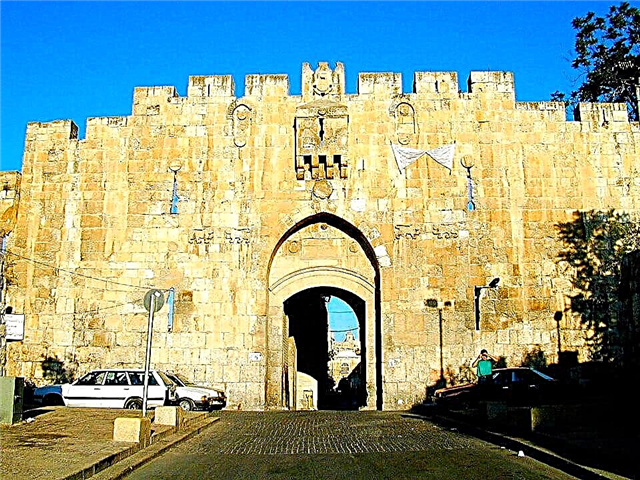Address: Russia, Saint Petersburg, Isaakievskaya square
Building: 1818 - 1858
Architect and author of the project: Auguste Montferrand
Shrines: honored copy of the Tikhvin Icon of the Mother of God
Height: 101.5 meters
Coordinates: 59 ° 56'02.8 "N 30 ° 18'23.6" E
Cultural heritage site of the Russian Federation
Content:
The largest church in St. Petersburg is named after Isaac Dalmatsky. The revered ascetic lived in Ancient Byzantium at the beginning of the 4th century. On the day of the church memory of the saint, May 30, 1672, the reformer Tsar Peter I was born, who erected the first St. Isaac's Church in the city. The modern cathedral is the fourth temple in a row, and it is rightfully considered an outstanding monument of classicism.

Isaac's Cathedral from a bird's eye view
Precursor temples
The first church in honor of Isaac of Dalmatia appeared in 1710. For the construction of a one-story building with a bell tower and a spire, an architect from the Netherlands, Hermann van Boles, was invited.
In the winter of 1712, it was here that the wedding of Tsar Peter I and Catherine I took place. Later, the Tsar personally disassembled the temple soaked in ship pitch, as it turned out to be too small.

Models of the first, second and third St. Isaac's Cathedral (from right to left)
Five years later, the second church was laid in the style of "Peter's Baroque", but it was completed after the death of the sovereign. The new temple stood about the same place where the Bronze Horseman flaunts today. In architecture, it resembled the Peter and Paul Cathedral, and in the height of the spire it was equal to the Admiralty. The slender church was decorated with a clock that the king had brought from a trip to Amsterdam.
The Neva was notable for severe floods, and the water often undermined the temple foundation. This neighborhood was destructive, so it was decided to dismantle the building and put it down in a new place. In the summer of 1761, by a special decree of the Senate, Savva Chevakinsky became the architect of the new church. However, for a number of reasons, this project was never implemented. The only thing that the architect managed was to choose a place for the future cathedral.

A few years later, Empress Catherine II ordered to start construction and chose the architect Antonio Rinaldi. The diligent architect built the church up to the cornice, but when the empress died, he left Russia. So Isaac's project began to resemble a classic long-term construction.
Paul I, who took the throne, hired the Italian architect Vincenzo Brenna. In the spring of 1798, he got down to business, however, due to funding cuts, he was forced to change the original project. As a result, simple brick walls have grown on a luxurious marble foundation. The massive building had a squat shape and distorted proportions. The project was completed in 1802. There were so many inconsistencies that it soon became clear that the cathedral would have to be overhauled.

How Isaac Rebuilt
In 1809, Russian Tsar Alexander I continued the construction of the temple. At first, they chose a cheap option and just wanted to rebuild the cathedral. But the competition held did not give any results. All submitted projects were found to be unsuitable. After 4 years, a new competition was announced, and again it ended in nothing.
The sovereign did not deviate from his plans and entrusted the preparation of the project to Augustine Betancourt. Thanks to the new architect, the business finally got off the ground. An experienced architect presented Auguste Montferrand, who had recently moved to Russia, to the court.
The tsar liked the drawings of the young architect, and the talented foreigner was promoted to "imperial architect". He was instructed to reconstruct Isaac, but the condition was set to completely preserve the altar part of the temple.

View of the dome of St. Isaac's Cathedral
In 1818, the architect brought to the attention of the tsar a reconstruction option, where not only the altar, but also the domed pylons of the already standing church were preserved. Interestingly, when designing the Russian temple, the architect took the classic buildings of the Pantheon and the House of Invalids in Paris as samples.
Construction began in the summer of 1819, and the consecration of the new cathedral took place in the late spring of 1858. For 40 years, Isaac has broken every conceivable record. It became the most expensive and longest-building church in Europe. They spent 23 million rubles on the construction.
To cope with the swampy ground, 10,762 piles were driven into the base of the building. The construction of the foundation lasted 5 years, and the installation of the granite columns took 2 years. More than 100 kg of gold were used for the gilding of domes with a diameter of almost 26 m. Three times more precious metal was used for the gilding of the interior details.

View of the observation deck on the dome of St. Isaac's Cathedral
About 400 thousand builders took part in the construction of the cathedral, and all of them were specialists in different fields. It is believed that between 60 and 120 people have died at the construction site. However, nowadays it is no longer possible to establish the exact number of victims and deaths.
Prediction
According to legend, a clairvoyant predicted to Montferrand that he would die soon after the completion of construction, so the architect was in no hurry. In fact, the large-scale project was so unique that it required non-standard solutions. The architect was in no hurry and corrected his own mistakes several times.
No matter how absurd the mystical prediction seemed, it came true. Literally a month after the consecration of the cathedral, the architect died. The cause of death was an acute attack of a chronic illness, which occurred after severe pneumonia.

Inside St. Isaac's Cathedral
According to the architect's will, they were to be buried in the new cathedral. But they never did it. The fact is that Montferrand professed the Catholic faith, and Isaac was built as an Orthodox church. The coffin was surrounded three times around the church, the liturgy was served, and the widow took the body of the deceased home to France. The architect, who had given so many years to Russia, was buried in the Parisian cemetery in the Montmartre district.
Architectural features
The temple was built in the traditions of late classicism and is crowned with a strict five domes. The large dome is octagonal. The facades of the building are decorated with expressive porticos of the Corinthian order.
Isaac is famous not only for impeccable classical forms, which are admired by city residents and tourists with pleasure. This is the tallest of all the buildings that stand on the main squares of the city - Admiralteyskaya, Dvortsovaya, Isaakievskaya and Senatskaya. The height of the building with a dome is 101.5 m.The cathedral reaches a length of 111.3 m and a width of 97.6 m.

Around the temple complex there are 112 monumental columns made of monolithic granite, the material for which was mined near Vyborg. On some of them, you can see the potholes from the explosions of shells left over from the war.
Sculptures
The ensemble of the cathedral is decorated with over 350 sculptures. They were carved by talented craftsmen of their time, who worked under the direction of Ivan Vitali. The sculptures are located near all four facades and above the gables of the temple.
The main theme of the statues is the history of Christianity and the revival of the executed Christ. In addition, the sculptures depict Isaac of Dalmatia's meeting with the Emperor Theodosius. It is curious that the ancient emperor is extremely similar to the Russian sovereign Nicholas I.

Isaac today
In the 19th century, the cathedral was owned by the Ministry of the Interior. From the very beginning, various exhibitions were held in the temple. In addition, the temple building was used for church services.
Today the majestic Isaac is an outstanding architectural monument of classicism. It has been operating as a museum since 1948. Many tourists come here to climb the observation deck and admire the grandiose views of the historical buildings from above.
In 1990, services were resumed here, and today services are held every day. At the same time, the cathedral continues to receive tourists.Many travelers pay for the excursion and listen with pleasure to the guide's story about the history of long construction and the fate of the architects who built Isaac.

Visitors are shown artistic decoration and rare museum exhibits. They can see beautiful mosaics, large-scale murals, stained glass windows, as well as columns and interior details made of lapis lazuli, porphyry, malachite and multicolored marble.
Useful information for tourists
The doors of the temple are open on any day, except Wednesday, from 10:30 to 18:00. A ticket for adults costs 250 rubles, for pensioners and students - 50 rubles. Children are admitted free of charge. For a walk through the colonnade, they pay 150 rubles (2019).
After 18:00 you can enter the cathedral with special tickets - for 400 rubles. An evening walk through the colonnade costs the same (2019).

Model of scaffolding designed by A. Betancourt for lifting columns
How to get there
The famous temple is within walking distance of the Admiralteyskaya, Sennaya Ploschad, Sadovaya and Spasskaya metro stations.











